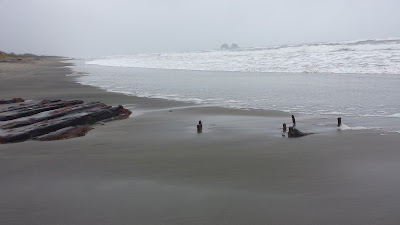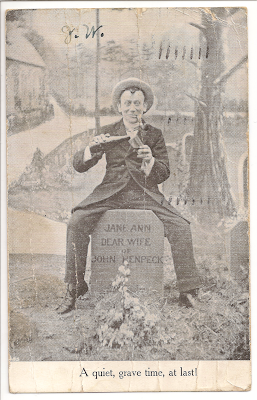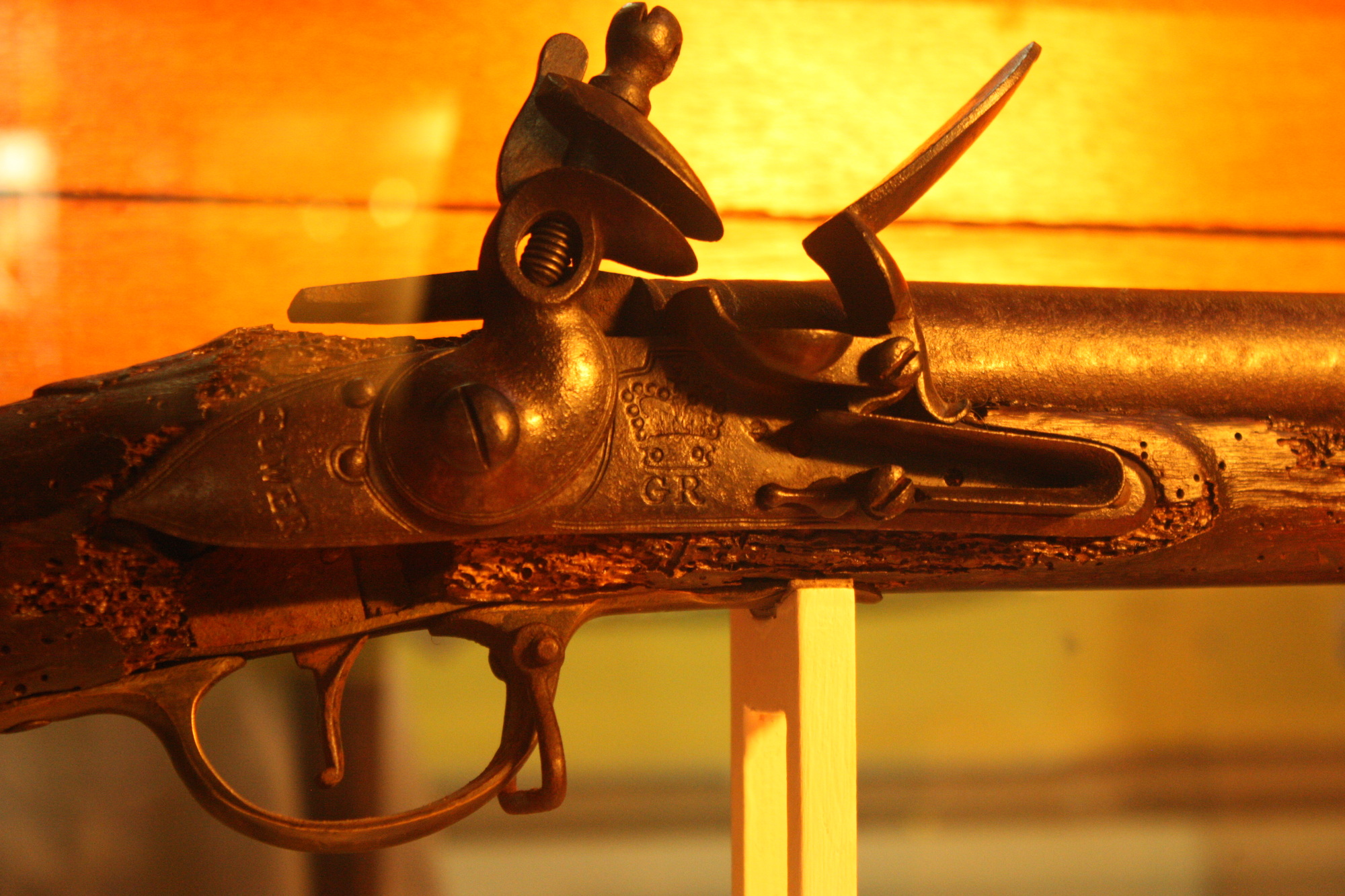In
the town of Rockaway Beach, buried beneath the sand, rests the broken
skeleton of a wooden barque called the Emily
G. Reed. Over a hundred
years ago, in 1908, she foundered in a storm and broke up, the pieces
of her hull scattered from the north jetty to just south of St.
Mary’s By the Sea, the local Catholic church. Most of the time her
timbers remain hidden under the deep sand, and tourists play
unknowingly upon the ship’s grave, but every once in a great while
the forces of nature shift the sands and the old boards again appear.
The
Oregon coast is home to many shipwrecks, and each has its story, but
few can equal the drama in that of the Emily
Reed. It began early on
a Valentine’s Day morning, not long after midnight. Captain Kersel
was endeavoring to sight Tillamook Rock in his journey northward from
Australia to Portland with a load of coal. For several days the
weather had been heavy, and he had to put much reliance on his
chronometer, making mathematical computations to determine the
longitude.
But
then came the terrible realization: the chronometer was wrong. The
ship was too far to the east, almost in the breakers. But this
realization came too late. “We had scarcely a minute’s
warning of breakers before the shock came,” recalled one of the
survivors. The Emily Reed hit the beach bow on, and
immediately began to break up. The first mate, Fred Zube, was
forward, calling all hands on deck. The captain, his wife, and some
of the crew were aft when the jolt came. A huge wave washed over the
bow, smashing one of the lifeboats. Seamen Abilstedt and Jahunke, as
well as the cook, whose name no one seems to have known, “came
tumbling out of the forecastle with scarcely any clothing on their
backs.” The three of them, led by Fred Zube, were unable to get to
the other end of the ship, and their end was deep in churning water,
so they quickly jumped into the remaining lifeboat and cut the
lashings. Captain Kersel and the others, clinging to the roof of the
aft-house, watched as a huge wave broke, and the lifeboat
disappeared.
After
witnessing this calamity, the captain ordered those who were with him
to stay on the wreck until daylight broke. As the sea calmed, he sent
his wife below, but he himself remained on the poop. When daylight
came, low tide came with it. Some of the crew decided to see if they
could swim ashore, first tying a rope to the wreckage. When they
jumped overboard, they discovered that they could touch bottom and
simply walk to land. The captain, his wife, his second mate, and the
three other seamen who had survived all waded to shore.
Captain
Kersel then had the sad duty of reporting the deaths of his crew. It
was a long list, and most newspapers carried the headline “Eleven
Lives Lost,” though, if the cook’s name were truly unknown, it
seems the number was actually twelve:
First
Mate Fred Zube (or Dubie)
Ship’s
Carpenter Westlund
Seaman
Sortzeit
Seaman
Johnson
Seaman
Dickson
Seaman
Darling
Seaman
Cohenstad
Seaman
Gilbert
Seaman
Ewald Abilstedt
Seaman
Arthur Jahunke
Cabin
Boy Hirschfeld
The
cook
But
then, three days after the wreck, in Neah Bay, Washington, nearly two
hundred miles to the north, someone aboard the sloop Teckla
heard by a feeble hail. The crew looked out and saw a steel lifeboat
slowly drawing near. There were four figures in the boat, three just
barely alive and one dead. Their tongues were so swollen from thirst
that they could scarcely articulate. But after some much-needed food
and drink, the leader of these men was able to tell his story.
They
were, in fact, from the wreck of the Emily Reed, the lifeboat
which the captain and the others had thought to be swamped. The wave,
instead of swamping them, had swept the lifeboat to sea. They were
alive, but without supplies. They had no food, no water, and only one
oar. Fred Zube had a broken arm. A biting wind blew most of the time,
and we know that Abilstedt, Jahunke, and the cook were barely
dressed. The boat had been banged around in the wreckage, and had
been punctured in several places, and the men had nothing with which
to bale out the water.
They
wore out their knives cutting away a compartment built into the boat,
but once they wrenched it off they were able to use it as a baler.
They set their course, clumsily managed with the single oar, away
from shore, hoping to fall into the shipping lanes and thereby meet a
steamship. The shore on this part of the coast they thought to be
“desolate,” which wasn’t exactly true, but wasn’t much of an
exaggeration, either.
On
the second night, they saw lights on the shore, but it was too dark
to chance venturing in. The cook declared he couldn’t stand the
thirst anymore, and he took a drink of seawater. It was not long
before he became delirious and lay down in the water at the bottom of
the lifeboat.
The
next morning, jubilation! There was a big steamer, and she stopped
near them. One of the men shook the cook awake. “Don’t you want
to be saved?” he asked, pointing to the steamer. The cook stood up,
watching the ship. But apparently it had not seen them after all, for
it was soon under weigh again. This seemed to break the cook’s
spirit, and within a half hour he was dead.
The
Tattoosh Island lighthouse appeared in the distance a few hours
later, and they drew together their strength to steer the boat into
the bay. “Sunday seemed the worst day we were out. We kept seeing
all sorts of vessels passing back and forth but none of them would
answer our hail. We were generally too far off to be made out
plainly, I guess,” said Fred Zube. That is, until they finally met
up with the Teckla.
With
this news, the death toll of the wreck of the Emily Reed dropped
from twelve to nine. Few people had seen the wreck, the area being
largely uninhabited, but one Elmer D. Allen later described it thus:
“Among the last of the proud, old sailing ships, she lay fast in
the sand, broken in two with a pile of coal two stories high; masts,
spars and sails toppled and her cargo of coal dumped to the center
holding firmly the fore and aft. The beach was strewn with wreckage
and coal.”
The
area where it had met its fate, known at the time as Garibaldi Beach,
soon changed its name to Rockaway, and settlers began to swarm in.
The wreck on the beach awaited them, with its wealth of salvage. The
pioneers stripped it of its copper, selling it for scrap, and after
each storm collected the coal that washed up. The sands eventually
crept over the old wreck, hiding it from view most of the time, but
even today residents will sometimes find coal after a storm.
A
few weeks ago the Emily
Reed made one of its
rare appearances, for only the third time within my memory. I took
the opportunity to make the drive to the beach and take the pictures
featured on this page, and the occasion became a spontaneous family
reunion! My parents were there, and my uncle and aunt also drove down
to see the reclusive shipwreck.
Selected Sources:
“Disastrous Shipwreck,” The Argus, 19 Feb 1908, p. 7, col. 8; digital images, Trove (http://trove.nla.gov.au/ : accessed 2 Apr 2017), Newspapers: The Argus (Melbourne, Vic.: 1848-1957).
“Eleven
Lost on Emily Reed,” The
Spokesman-Review,
15 Feb 1908, p. 17, col. 1; digital images, Google
News
(https://news.google.com/ : accessed 2 Apr 2017), The
Spokesman-Review: Jun 16, 1889-Dec 31, 2007.
“Emily
Reed Disaster,” The
Sydney Morning Herald,
11 Jun
1908,
p. 8, col. 6; digital images, Trove
(http://trove.nla.gov.au/
: accessed 2 Apr 2017), Newspapers: The Sydney Morning Herald (NSW:
1842-1954).
“Perils
of the Sea,” Barrier
Miner,
6 Apr 1908, p. 6, col. 6; digital images, Trove
(http://trove.nla.gov.au/
:
accessed 2 Apr 2017), Newspapers: Barrier Miner (Broken Hill, NSW:
1888-1954).
Lori
Tobias, “Shifting
sands reveal 102-year-old shipwreck off Rockaway Beach,” The
Oregonian,
29 Dec 2010, online archives at OregonLive
(http://www.oregonlive.com/pacific-northwest-news/index.ssf/2010/12/shifting_sands_reveal_102-year-old_shipwreck_off_rockaway_beach.html
: accessed 2 Apr 2017).
“Survivors
of the Emily Reed,” Lewiston
Evening Journal,
18 Feb 1908, p. 1, col. 5; digital images, Google
News
(https://news.google.com/ : accessed 2 Apr 2017), Lewiston Evening
Journal: Apr 20, 1861-Jul 26, 1980.












